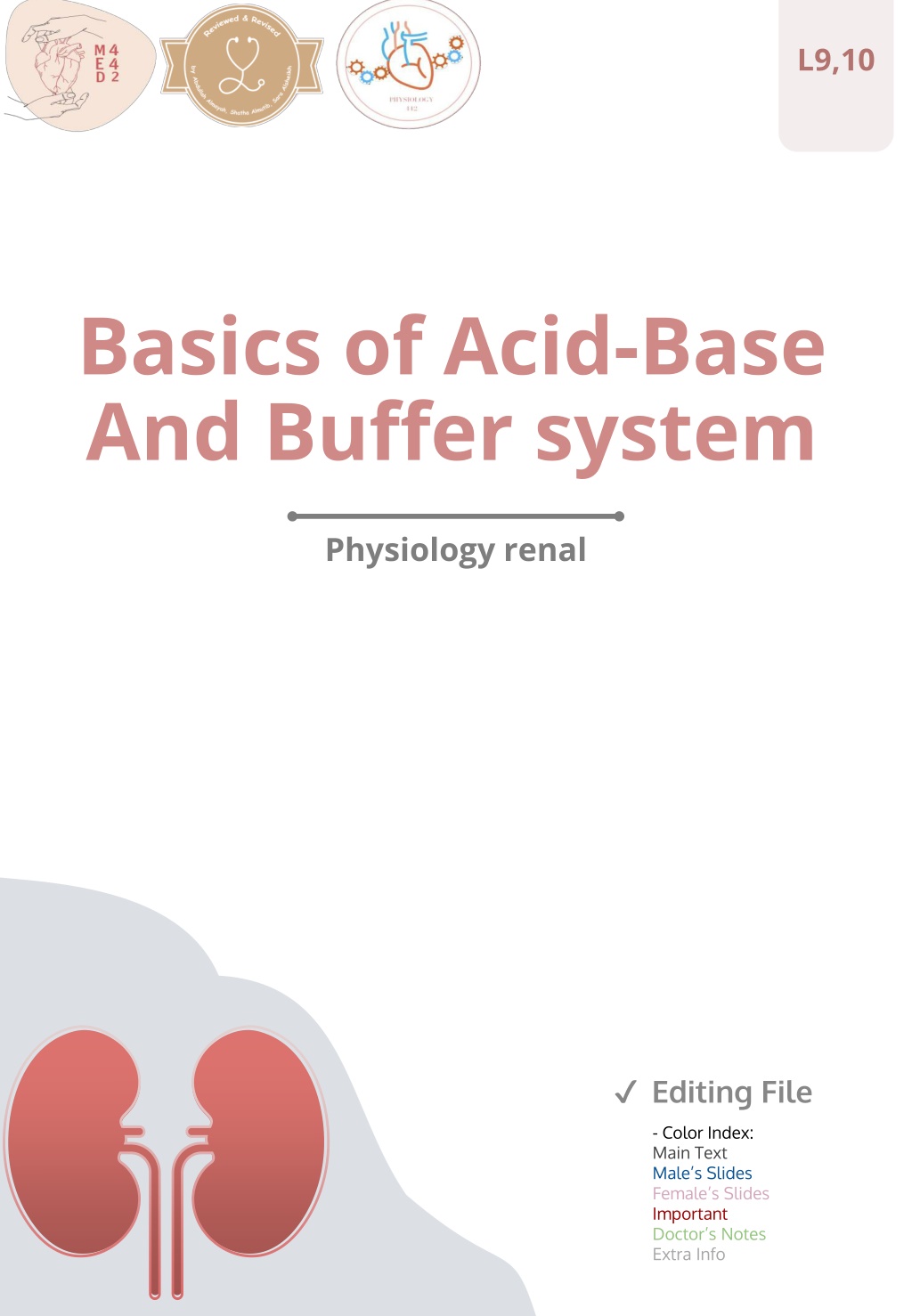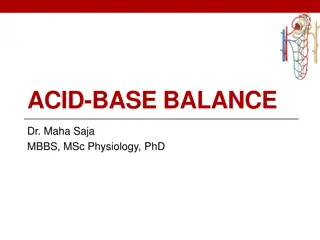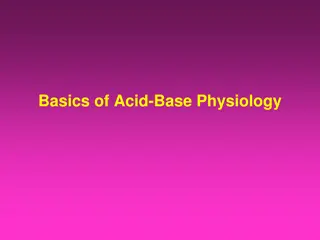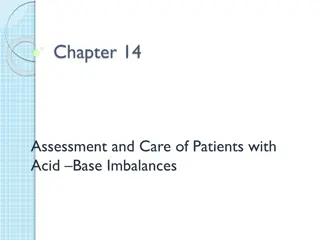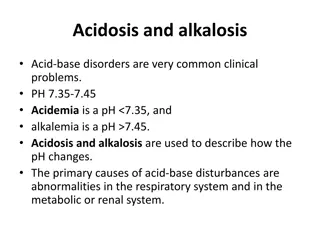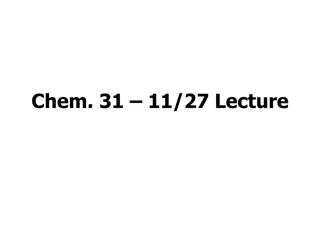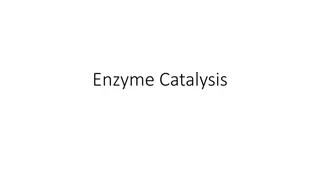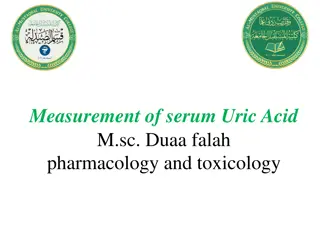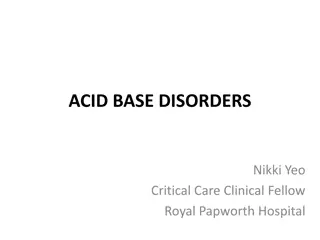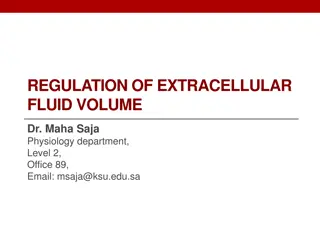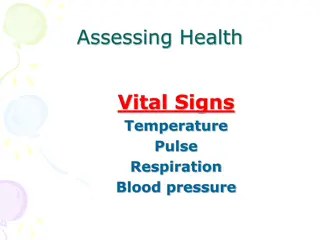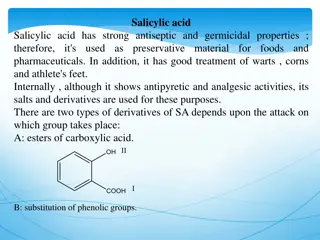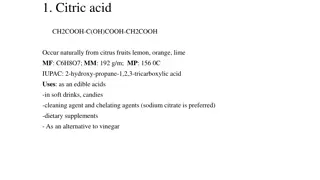Understanding Acid-Base Balance and Regulation in the Body
Acid-base balance is crucial for maintaining optimal physiological functions. This content explains the definitions of acids and bases, differentiates between strong and weak varieties, explores the significance of pH control in body fluids, and delves into the roles of buffers, kidneys, and lungs in regulating acid-base balance. It covers the production of acids in the body and provides insights into how the body defends against changes in pH levels. Overall, it offers comprehensive knowledge on the fundamentals of acid-base physiology.
Download Presentation

Please find below an Image/Link to download the presentation.
The content on the website is provided AS IS for your information and personal use only. It may not be sold, licensed, or shared on other websites without obtaining consent from the author. Download presentation by click this link. If you encounter any issues during the download, it is possible that the publisher has removed the file from their server.
E N D
Presentation Transcript
L9,10 Basics of Acid-Base And Buffer system Physiology renal Editing File Editing File - Color Index: Main Text Male s Slides Female s Slides Important Doctor s Notes Extra Info
Objectives Define: acid and base. Explain what is meant by strong and weak acids and bases. List and identify the names/formulas for the common strong acids and strong bases. To explain the role of Henderson-Hasselbalch equation in acid base regulation. To define buffer system and discuss the role of blood buffers and to explain their relevant roles in the body. To describe the role of kidneys in the regulation of acid-base balance. To describe the role of lungs in the regulation of acid-base balance. Contents What are acids and bases? What is meant by a weak and a strong acid or base? What is the normal pH of body fluids? Why is it important to keep body fluid pH within certain limits? What are the body s defense mechanisms against changes in blood pH: body buffers, the lungs and the kidney. Understand the role of the kidney in regulating pH of body fluids
1 Acids and Bases Helpful video Helpful video Acid-Base Balance Acid-base balance is concerned with the precise regulation of free (unbound) hydrogen ion (H +) concentration in body fluids. Normally, [H+] = 0.00004 mEq/L (40 nEq/L). Why Should [H+] be Tightly Controlled? Slight deviations in [H +] have profound effects on enzyme and protein activity and thus the body s metabolic activity in general. Changes in [H+] affects K+ levels in the body. A number of processes can alter [H +] concentration in the body, such as; Generation of acids & bases from amino acid/protein metabolism. Metabolism of ingested food. Example: glycolysis 1 3 2 4 Changes in CO2 production. GI secretions. Acid-Base Fundamentals Acid Base a molecule that can release H + in a solution. The free H [H+] is the one how can change the pH a molecule that accepts H+ in a solution. Definition H2CO3 (carbonic acid) HCl (hydrochloric acid) Bicarbonate ions (HCO3-). Hydrogen phosphate (HPO4-2) Examples
Strong VS Weak Acids & Bases 2 Strong acids : dissociate rapidly and release large amounts of H+ in solution Weak acids: dissociate incompletely and less strongly releasing small amounts of H+ in solution Weak Acids AH A- + H+ Acid Conjugate base + H+ The extent to which a given acid dissociates in solution is constant. Also known as the Dissociation constant ( K ). K = [ H+ ][ A- ] [ AH ] H2CO3 HCO3- + H+ K= [H+][HCO3 -] [H2CO3] What is pH? pH is a way of expressing H + ion concentrations. pH = log 1 Or pH = -log [H+] If the [H+] increase pH will decrease (more acidic) If the [H+] decrease > pH will increase (more alkaline) [H+] [H+] (mEq/L) pH What is the normal pH of the ECF? Normally pH= 7.35-7.45 pH < 6.8 Acidosis (Death) pH > 8 Alkalosis (Death) Extracellular fluid Arterial blood 4.0 X 10-5 7.4 Venous blood 4.5 X 10-5 7.35 Interstitial fluid 4.5 X 10-5 7.35 Intracellular fluid 1 X 10-3 to 4 X 10- 5 6-7.4 Urine 3 X 10-2 to 1 X 10- 5 4.5-8 Gastric HCl 160 0.8
3 Acid Production by the Body The body produces large amounts of acids on daily basis as by products of metabolism. Metabolism of dietary proteins. Anaerobic metabolism of carbs and fat. Acids in the body are of two kinds: 1. Volatile (CO2) 2. Non-volatile fixed (sulfuric acid, lactic acid) (daily acid load 50-100 mEq/day) (0.8 mEq/kg/d). The Body s Defense Against Changes in [H] Three main systems: 1. Body fluid buffers: Works within seconds.It doesn t take rid of the H+ it just hides them until the kidney or the lungs(if it s a volatile acid )start to work 2. Lungs: Works within minutes. It has a limitation > cannot take rid all of the body s acids ,just the volatile aids 3. Kidneys: Works within hours-days ,The most powerful of the three. What is a Buffer? A buffer = a solution that resists changes in pH upon addition of small amount of acids or bases. Neutralizes small additions of bases/acids pH remains constant How do Buffers work? A buffer is a mixture of a weak acid and a weak base that are in equilibrium. To be more accurate, its either made of: A weak acid and its conjugated base (H2CO3 & NaHCO3 /HCO3-). A weak base and its conjugated acid (NH3 & NH4+).
4 How does a buffer do its job? Weak acid The conjugated base (weak base) In female slides only The weak acid will dissociate incompletely into H+ and HCO3- And the weak base (NaHCO3) some of them will remains as NaHCO3 and some of them will dissociate incompletely into Na+ and HCO3- But if you add strong acid as HCl it will dissociate completely into Cl- and H+ So if the H+ will stay free it will lower the pH BUT the buffer will do its work by : The H+ from HCl will bind to HCO3- = H2CO3 The Cl- can combine to the Na = NaCl ( Because of this the strong acid is converted into a weaker acid So the buffer hide the H+ (The same concept but here we added a strong base ) The weak acid will dissociate incompletely into H+ and HCO3- And the weak base (NaHCO3) some of them will remains as NaHCO3 and some of them will dissociate incompletely into Na+ and HCO3- But if you add strong base as NaOH it will dissociate completely into OH- and H+ So if the H+ will stay free it will lower the pH BUT the buffer will do its work by : OH- will bind to H+ = H2O Na+ will bind to HCO3- = NaHCO3 Because of this the strong Base is converted into a weaker base So the buffer hide the H+ pH) Chemical Buffer Systems in the Body There are 3 chemical buffers in the body: 1. The Bicarbonate buffer system. 2. The phosphate buffer system. 3. Proteins. They are the 1st line of defence against changes in pH i.e.[H+], act within seconds. Some are more powerful extracellularly and others are more powerful intracellularly. The Bicarbonate Buffer System Composed of: A weak acid (H2CO3). Its conjugated base (NaHCO3 / HCO3-). CA CO2 + H2O H2CO3 H+ + HCO3- NaHCO3 Na+ + HCO-3 CA: carbonic anhydrase
5 The Bicarbonate Buffer System 1 H2CO3 forms in the body by the reaction of CO2 &H2O CO2 +H2O H2CO3 2 H2C 3 ionizes weakly to form small amounts of H+ & HCO-3 H2CO3 H+ & HCO3- 3 The second component is NaHCO3 which dissociates to form Na+ & HCO3- NaHCO3 Na+& HCO3- Putting all together ; This is the main ECF buffer system What happens if you add a base or an acid to the system?
6 The Henderson-Hasselbalch Equation What is the HHE? It is an equation that enables the calculation of pH of a solution. What is it? HCO3- 0.03 X PCo2 (Conjugate base ) pH= pK + log (Weak acid) K = dissociation constant, pK = 6.1 solubility of CO2= 0.03 How was it derived?(Not important just for your understanding) H2CO3 H+ + HCO3- 1 H2CO3 and its dissociated ions are always in equilibrium the products of the reaction on one side of the equation are proportional to the product on the other side. [H2CO3] [H+ ] X [HCO3-] 2 Since H2CO3 is a weak acid, it will not dissociate completely and the concentration of its products will depend on its dissociation constant (K) K X [H2CO3] = [H+ ] X [HCO3-] Both doctors said you only have to memorize the final formula, not the derivation it is not with us How was it derived? H2CO3 HCO3- + H+ K= [H+][HCO3 -] [H2CO3] [H+] = ? ? [H2CO3] ?? = ?? + log [???? ] [HCO3 ] [S.CO2 PCO2] Taking log and * by-1 solubility of CO2 (0.03 mmol/mmHg) 24?? ?/? 0.03?40 ?? = ?? + log [24mEq/L] ????+ = ???? ???[H2CO3] [0.03X40] [???? ] ?? = ?? + log [24mEq/L] ?? = ?? + log[???? ] [1.2mEq/L] [H2CO3 ] pK is dissociation constant of carbonic acid in the blood = 6.1 ?? = 6.1 + log [24mEq/L] ?? = ?? + log [???? ] [H2O+CO2] [1.2mEq/L] ?? = ?? + log[???? ] Blood pH = 7.4 [CO2 ]
7 Cont 3 Based on the previous equation, [H +] can be expressed as follows; [H+]=K X [H2CO3] [HCO3 ] 4 Because H2CO3 can rapidly dissociate into CO2 and H2O. And since CO2 is much easier to measure it can replace H2CO3 in the equation [H+]=K X [CO2] This is Henderson s equation (1908) [HCO3 ] It means that; [CO2] [H +] [HCO3-] [H+] 5 In 1909, Sorensen created the pH scale to express [H + ] pH = - log [H+] 6 In 1916, Hasselbalch decided to merge Henderson s equation with Sorensen s pH scale creating what we now know as the Henderson- Hasselbalch equation . [H+] = K X [CO2] -log[H+]= -log K X [CO2] [HCO3-] [HCO3-] -log[H+]= -logK -log [CO2] [HCO3-] pH =pK + log [HCO3-] This is Henderson-Hasselbalch equation (1908) 7 [CO2] Since it is much easier to measure PCO2 rather than dissolved [CO2] and because dissolved CO2 is proportional to PCO2 multiplied by the solubility of CO2 (0.03 mmol/mmHg) [CO2] was replaced by PCO2 X 0.03 pH =pK + log [HCO3-] Ta-Da 0.03 X PCO2
8 Buffering Systems Buffer systems work together in body fluids (not independently) A change in the balance of one buffer system, causes a change in the other systems Buffers do not reverse the pH change, they only limit it Buffers do not correct changes in [H+] or [HCO3-], they only limit the effect of change on body pH until their concentration is properly adjusted by either the lungs or the kidney. The most important buffer system in the ECF The Bicarbonate Buffer system CA: Carbonic Anyhydraze Regulated by the kidney HCO3- pH PCo2 Regulated by the lungs HCO3- Ratio = 20:1 HCO3 will pH PCO2 PCO2 will pH The Phosphate Buffer Plays a major role in buffering intracellular & renal tubular fluid. Proteins Contributes to buffering inside cells. E.g. Hb. Composed of: H2PO4- (dihydrogenphosphate) (as weak acid) HPO4-2 (Hydrogen phosphate) (as its conjugated base)
9 Respiratory Regulation of CO2 2nd line of defence against acid-base disturbances in the body. It does this by: By modulating CO2 excretion. ventilation (RR) PCO2 [H+] ventilation (RR) accumulation of CO2 PCO2 [H+] Normally, PCO2 = 40 mmHg (35-45 mmHg) Female s slides In case of acidosis or alkalosis: Acidosis: ( [H+]in ECF) ventilation PCO2 [H+] Alkalosis ( [H+] in ECF) inhibit ventilation ventilation (RR) accumulation of CO2 PCO2 [H+]
10 Overview of Reabsorption and Excretion in Tubules Reabsorption of HCO3- is linked to H+ secretion H+ secretion occurs in all tubular segments except thin descending & ascending loops of Henle
11 Renal Regulation 3rd line of defence against acid-base disturbances and the most powerful. It regulates by excreting either an acidic or basic urine. It does this by: Secreting H+ Reabsorbing HCO3 Generating new bicarbonate ions. PCT reabsorption of HCO3- 1. Secreted H+ binds to filtered HCO3- in the tubular lumen Forming H2CO3 which dissociates into H2o and CO2 CO2 diffuses through tubular cell membrane and react with water for min H2CO3 inside the cell 2ndary active transport 2. 3. - - - - here no loss for H+ I can t reabsorbe HCO3- if I don t have H+ H+ secretion = HCO3- reabsorbing Here I reabsorber HCO3- but not the same molecule that have been filtered (indirectly Late DCT & CT reabsorption of HCO3- The filtrate arriving at the DCT & CT is low in HCO3-. The distal segments of the nephron are characterized by the presence of intercalated cells capable of actively secreting H+ through H+-ATPase and H+-K+ ATPase present on their apical membrane (Type-A intercalated cells). Only a limited number of H+ can be excreted in its free form in urine. Lowest possible urine pH=4.5 0.04 mmol/L of free H+. Female s doctor said you have to know the intercalated cell type A only
12 Renal Regulation 1. CO2 combines with H2O witching type A intercalated cells, forming H2CO3 H2CO3 splits forming H+ & HCO3- H+ is secreted into the filtrate by H+ ATPase pump For each H+ secreted, a HCO3- enters the peritubular capillary blood via antiport carriers in a HCO3-/Cl- exchange H+ combines with (HPO4)2 forming H2PO4- Which is then excreted 2. 3. 4. 5. Phosphate buffer system (Filtered) 6. Excretion of H+ as phosphate is capable of handling a limited amount of H+ and will not be enough to rid the body of its daily acid load nor if there is unusually high acid production. Non-Bicarbonate Buffers in the Tubular lumen Ammonia Buffer system (Synthesized) NH3 Ammonia + H+ < > NH4+ Ammonium (Weak base). (Its conjugated acid) Renal tubular cells, especially PCT, are capable of ammoniagenesis (generating ammonium) which is then excreted in urine carrying with it H+. The rate of ammoniagenesis can be modified according to the needs of the body. Quantitatively, the ammonia buffer system is more important than the phosphate buffer system for H+ excretion in urine. It is the most important system in case of acidosis. Here we generate more HCO3- in comparison with phosphate buffer system
13 Female s slides Types of intercalated cells -IC (type A-IC) secrete hydrogen -IC (type B-IC) secrete bicarbonate
14 Renal Regulation The overall scheme of renal excretion of acids & bases To excrete acids 1. Freely filter HCO3- To excrete bases 1. Freely filter HCO3- 2. Reabsorb the majority of filtered HCO3 2. Reabsorb the majority of filtered HCO3 3. Reabsorb some additional HCO3- 3. Reabsorb some additional HCO3- 4. Secrete H+ (titration filtered bases, i.e. HPO42-) 5. Excrete acidic urine containing NH4+ 4. Secrete some HCO3- 5. Excrete alkaline urine containing HCO3- Factors affecting H+ Secretion and HCO3- Reabsorption Increase H+ secretion and HCO3- Reabsorption Decrease H+ secretion and HCO3- Reabsorption Increase PCO2- Decrease PCO2- Increase H+, Decrease HCO3- Decrease H+, Increase HCO3- Decrease Extracellular fluid volume Increase Extracellular fluid volume Increase Angiotensin II Decrease Angiotensin II Increase Aldosterone Decrease Aldosterone Hypokalemia Hyperkalemia
15 summary Buffer System Buffer systems do not work independently in body fluids but actually work together. A change in the balance in one buffer system, changes the balance of the other systems. Buffers do not reverse the pH change, they only limit it. Buffers do not correct changes in [H+] or [HCO3 -], they only limit the effect of change on body pH until their concentration is properly adjusted by either the lungs or the kidney. Here is a file that contains pages from guytone textbook about our lecture
Quiz Q1 What is a buffer made of? A. A weak acid only B. A weak acid and its conjugate acid C. A weak acid and a weak base D. A weak acid and a conjugate base Q2 Which of the following is not a buffer system in the kidneys? A. The bicarbonate buffer system B. Proteins C. The phosphate system D. The ammonium system Q3 What is a normal pH level for humans? A. 6.9 B. 7.0 C. 7.4 D. 6.5 Q4 What is the most important system for acidosis? A. The ammonium system B. The bicarbonate system C. The lungs D. Proteins
Quiz Q5 What is the ratio of HCO3-/PCo2? A. 12:5 B. 6:5 C. 20:1 D. 7:45 Q6 What is organ regulates HCO3-? A. Lungs B. Kidney C. Heart D. Stomach Answers: 1-D, 2- B, 3- C, 4-A, 5-C , 6-B SAQs Name a few factors that increase H+ secretion and HCO3- reabsorption: Increase PCO2-, Increase H+, Decrease HCO3-, Decrease Extracellular fluid volume, Increase Angiotensin II, Increase Aldosterone, Hypokalemia SAQs What are the types of acids in the body? Volatile and non volatile
Members Team Leaders Razan Almohanna Raneem Alwatban Khalid Alrasheed Othman Alabdullah Team Members Razan Alotaibi Hassan AlAbdullatif Theme was done by Shatha Almutib physio442@gmail.com
